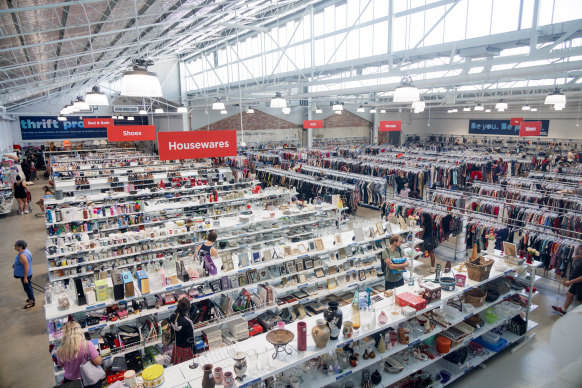
But even at a thrift shop, purse strings have tightened.
“What we’ve seen over the last 12 months is more footsteps in stores, but they’re spending a little less,” he said.
“Historically, our target audience has been younger females between 18 and 34. However, that has changed, and we’re really starting to see a diverse range of customers walk through the doors of our stores.”
Loading
In a world where vintage and op-shopping has become a more luxe and upmarket experience, Fisher said more than half of Savers’ 900 staff were extensively trained to sort and determine the condition and cost of merchandise – the average item price is $5.66. Only about 5 per cent of donations will end up in landfill. Some products that linger on shelves too long, like glass or tea sets, might be diverted to “smash” or “rage” rooms, or end up as road fill.
Fisher said he has strolled through some op-shops in Sydney’s Newtown and had been shocked at some of the tags. “I saw a secondhand Green Bay Packers t-shirt and it was $80. I was blown away by that price,” he said.
“We don’t have any intent to do that… If the condition [of the item] doesn’t meet above average, we couldn’t put a larger price on it. It’s just not the right thing to do.”
As many as 10,000 new items are added every weekday, encompassing a range of categories including homewares and books, though most products are clothing and footwear. Most items don’t have a long shelf life longer than three weeks, and stock moves quicker at Savers than it might at a traditional op-shop, says Fisher.

Inside a Savers Australia thrift store.
As much as cost of living is drawing people in stores, it is not the only factor behind the NSW expansion.
“Globally, we have a growth strategy, and Australia falls into that,” Fisher said. “That’s what makes [the NSW expansion] the right time for us. The cost of living crisis might be an unintended benefit of sales. It’s certainly not the sole driver of it.”
Loading
The US thrift store chain is headquartered in Washington and is a $US2.2 billion ($3.3 billion) business listed on the New York Stock Exchange, with more than 300 locations across Canada, US and Australia.
Savers Australia’s most recent financial report, filed to the corporate regulator in September 2022, shows the company booked net losses of nearly $54.4 million for the financial year ending January 2, 2021.
Fisher did not directly respond to questions about whether each store is currently profitable. “What I would say is that we’re running a really sound business here in Australia,” he said.
“We see profit as providing great value in a second-hand retail environment. We see that there’s a strong organisation that supports their 900 team members. I’d say we’re having a profitable impact on the environment and, then lastly, what we’re paying our not-for-profits for the items that they collect is providing profit for them.”
Savers’ charity partners have received more than $22 million over the past five years, Fisher said.
The NSW store is set to open on May 30 and will be based in Hoxton Park Central, eight minutes from Liverpool, in Sydney’s western suburbs. The location was chosen because it could accommodate the “big box” retail space, similar in size to an Officeworks.
Fisher already has his eye on the next few store openings – and is considering some closer to the central business district and others around Wollongong and Newcastle – which he says shouldn’t take as long to reach the same scale as Victoria’s outlets.
“It will not take 25 years to open more stores in NSW.”



























